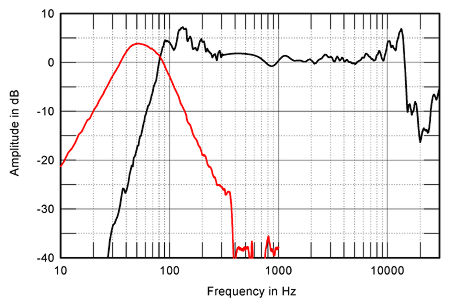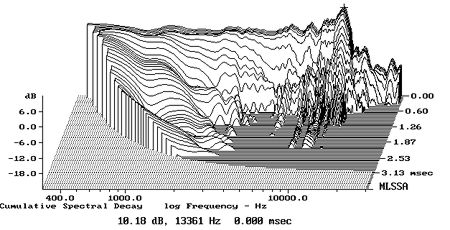| Columns Retired Columns & Blogs |
mbl 101E Radialstrahler loudspeaker Measurements
Sidebar 3: Measurements
MBL specifies the 101E Radialstrahler as having a low sensitivity of 81dB/2.83V/m. My estimate came in at 80.5dB(B)/2.83V/m, which is within the margin of error of the specified figure. However, because of its true omnidirectional radiation pattern (see later), the 101E will tend to sound louder in-room than this anechoic sensitivity rating implies. As revealed by its impedance plot (fig.1), however, the speaker is definitely a 4 ohm load, meaning that a good amplifier rated at 4 ohms will be needed to drive it. The actual minimum impedance is 3.4 ohms at 415Hz, but probably of more concern is the combination of 4.9 ohms and a 46 degrees capacitive phase angle at 38.5Hz. Biamping the mbl should lessen the current demand on the amplifier; fig.2 shows the individual impedances of the bandpass woofer and omnidirectional midrange/tweeter enclosures. But note that the higher-frequency section still has a difficult combination of magnitude and negative phase angle at around 150Hz.

Fig.1 mbl 101E, electrical impedance (solid) and phase (dashed). (2 ohms/vertical div.)

Fig.2 mbl 101E, individual electrical impedance (solid) and phase (dashed) of upper-frequency and bandpass woofer sections (2 ohms/vertical div.).
The impedance traces were free from the wrinkles that would indicate the presence of cabinet resonances, and I couldn't find any of significance in the bandpass enclosure (not shown). The small saddle at 48Hz in the impedance magnitude trace is due to the tuning frequency of the bandpass-loaded woofer's twin vents. While in a conventional reflex design this would imply only modest low-frequency extension, correlating with the speaker's -6dB frequency, in a bandpass design it indicates the peak of the speaker's output, as shown by the red trace in fig.3. The 101E is 6dB down just above 30Hz, which is pretty good extension for the size of the enclosure. Note also that this kind of bass unit rolls off below its tuning frequency with a second-order, 12dB/octave slope rather than the reflex design's 24dB/octave, which means that the usual room gain will extend the low frequencies to a greater extent than with a reflex.
The bugbear of bandpass designs is a tendency to out-of-band resonances. But looking at fig.3, the 101E's bandpass woofer is extremely well-behaved above the crossover to the omnidirectional midrange unit. Some sort of anti-resonant behavior is apparent at 400Hz, but the unit is well down in level at this frequency, which is more than two octaves above the crossover point.

Fig.3 mbl 101E, anechoic response on tweeter axis at 50", averaged across 30 degrees horizontal window and corrected for microphone response, with the nearfield midrange response plotted below 300Hz and the nearfield bandpass port response plotted in red.
All the measurements were performed with the rear-panel jumpers set to Smooth/Natural/Smooth, which is how MF auditioned the 101Es. The black trace in fig.3 shows the nearfield response of the large omnidirectional midrange unit spliced at 350Hz to the 101E's farfield response, averaged across a 30 degrees horizontal window on the tweeter axis. The rise between 80Hz and 300Hz is entirely due to the nearfield measurement technique—the 101E actually has a superbly flat response throughout the midrange and treble. Only in the top audio octave is there a bit of peakiness, but this is high enough in frequency that it will be perceived as extra "air" rather than as tilted-up highs.
I have been using the term "omnidirectional" throughout this section without comment. As fig.4 shows, the mbl 101E is indeed omnidirectional in the horizontal plane, its output at 90 degrees being identical to that at 0 degrees up to 7kHz. While there is some off-axis unevenness in the top audio octaves—perhaps due to reflections from the various struts that support the structures of the upper-frequency driver magnets—the speaker really does offer full-range omnidirectional behavior. In the vertical plane, the 101E's balance changes very little with the height of the listening axis (fig.5)—a good thing, considering that the speaker's tweeter is 45" from the floor.

Fig.4 mbl 101E, lateral response family at 50", normalized to response on tweeter axis, from back to front: differences in response 90 degrees-5 degrees off-axis, reference response, differences in response 5 degrees-90 degrees off-axis.

Fig.5 mbl 101E, vertical response family at 50", normalized to response on tweeter axis, from back to front: differences in response 15 degrees-5 degrees above axis, reference response, differences in response 5 degrees-15 degrees below axis.
The MBL's step response (fig.6) is a little hard to interpret, but it basically suggests that the drive-units are all connected with the same polarity. (This includes the output from the bandpass woofer ports.) The wrinkles at 4.5ms are due to early reflections from the speaker's structure, but note the wrinkles at the 7ms mark in this graph. These are due to reflections from the floor of the 101E's high-frequency output—because of the speaker's bulk, I was unable to lift it on to my usual high stand for the acoustic measurements. As a result, I had to aggressively window the impulse-response data to prevent the inevitable floor reflections from corrupting the 101E's waterfall plot (fig.7). Where this windowing would have affected the graph, the plot is replaced by dots. But other than above 10kHz (where the early reflections produce some hash) and below 2kHz (where the high-order crossover produces some delayed energy), the 101E's decay is very clean.

Fig.6 mbl 101E, step response on tweeter axis at 50" (5ms time window, 30kHz bandwidth).

Fig.7 mbl 101E, cumulative spectral-decay plot at 50" (0.15ms risetime).
Technically, MBL's 101E Radialstrahler is an intriguing design that works as advertised. From my own experience of the mbl 111B, which uses the same omnidirectional upper-midrange and treble units, I feel that the sonic presentation of this type of speaker can be addictive.—John Atkinson
- Log in or register to post comments




































